Introduction
Agra has long been the heart of Mughal architecture, and its monuments reflect the grandeur, romance, and power of one of the greatest empires in history. For travelers exploring India, visiting these historic landmarks is among the most essential things to do in Agra. Each site tells a unique story — of love, ambition, artistry, and faith — and together, they make Agra one of the world’s most remarkable heritage cities.
Historical & Iconic Monuments in Agra
Taj Mahal – The Eternal Symbol of Love
The Taj Mahal is not only one of the most famous places to visit in Agra but also one of the most recognized monuments in the world. Built by Emperor Shah Jahan in memory of his beloved wife Mumtaz Mahal, this white marble masterpiece remains a timeless tribute to love.
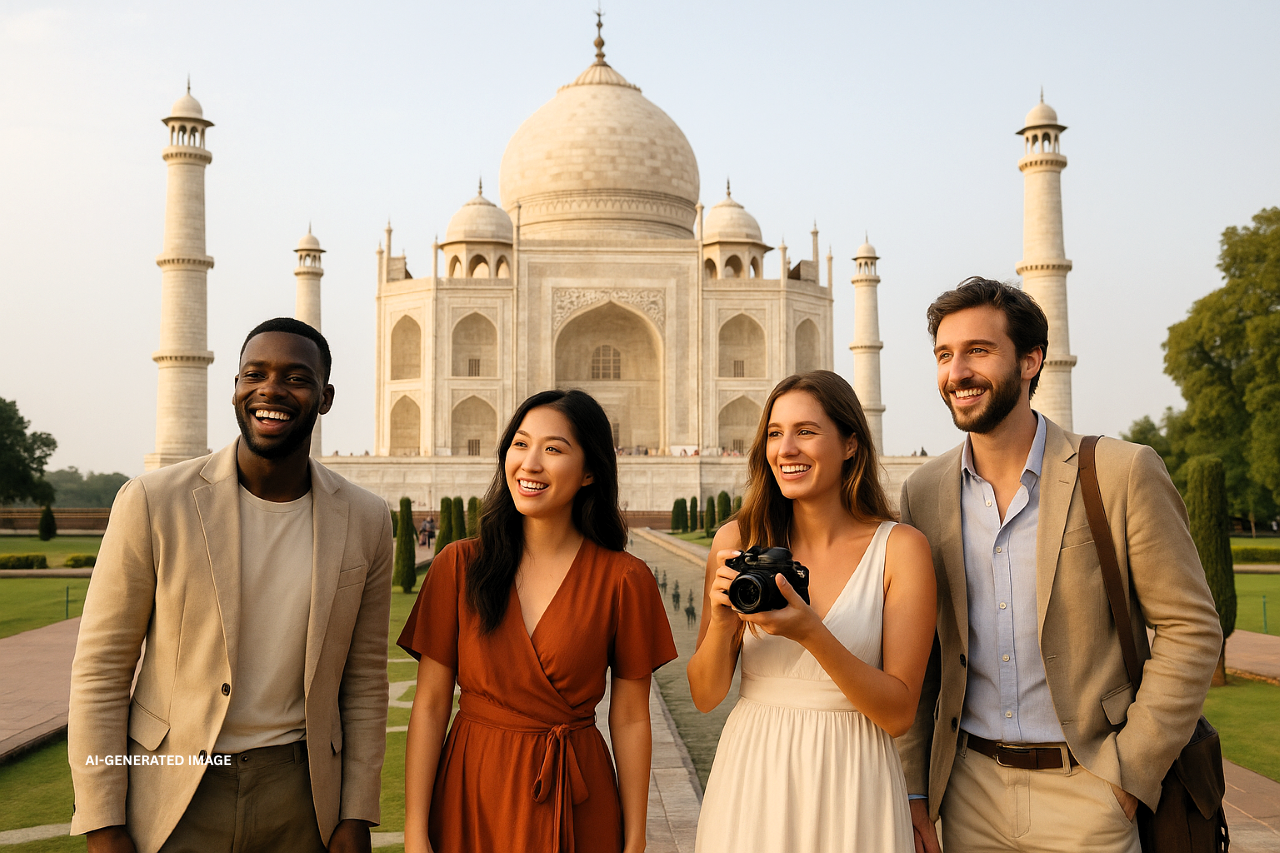
-
Historical Significance:
-
Construction began in 1632 and continued for more than two decades. Thousands of artisans and craftsmen worked on the project, combining Persian, Indian, and Islamic architectural styles.
-
What to Expect:
-
Visitors are captivated by its flawless symmetry, delicate marble inlay, and the way the monument’s colors change with the sun’s light. Walking through the gardens, admiring the reflecting pools, and stepping inside the mausoleum are all unforgettable experiences.
-
Tips for Visitors:
-
The Taj Mahal is most magical at sunrise or sunset, when the marble glows in soft hues. Remember that it is closed to the public on Fridays.
Agra Fort – A Royal Stronghold
Just a short distance from the Taj Mahal lies the Agra Fort, another UNESCO World Heritage Site and one of the most impressive things to do in Agra.
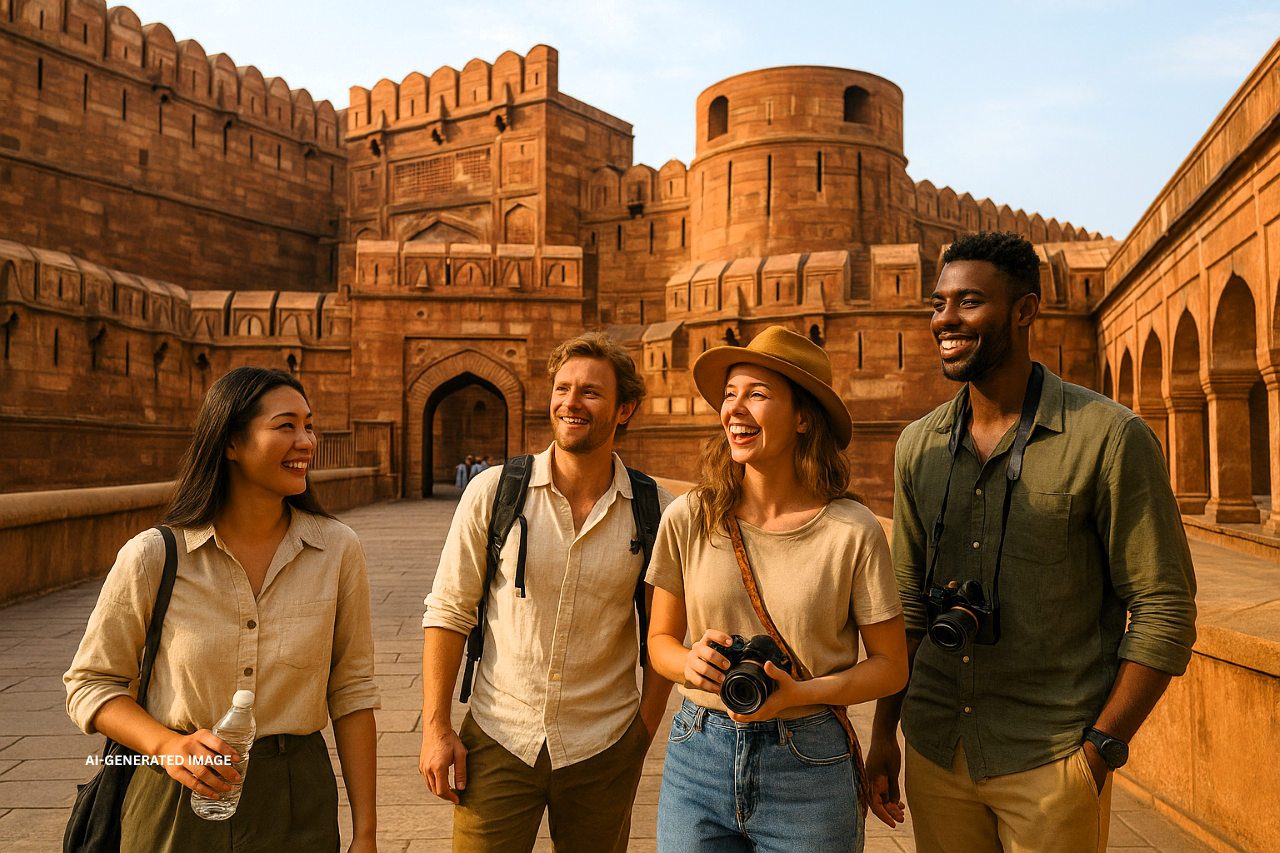
-
Architecture & Layout:
-
Commissioned by Emperor Akbar in 1565, the fort was later expanded by Shah Jahan. Built in red sandstone, it contains palaces, halls, and courtyards within its massive walls.
-
Highlights Inside:
-
Must-see areas include the Jahangir Palace, Diwan-i-Am (Hall of Public Audience), Diwan-i-Khas (Hall of Private Audience), and the Musamman Burj, where Shah Jahan is said to have spent his final years gazing at the Taj Mahal.
-
Why Visit:
-
From the ramparts of Agra Fort, visitors enjoy spectacular views of the Taj Mahal across the Yamuna River.
Fatehpur Sikri – The Ghost Capital
About 40 kilometers from Agra lies Fatehpur Sikri, one of the most fascinating places to visit near Agra.
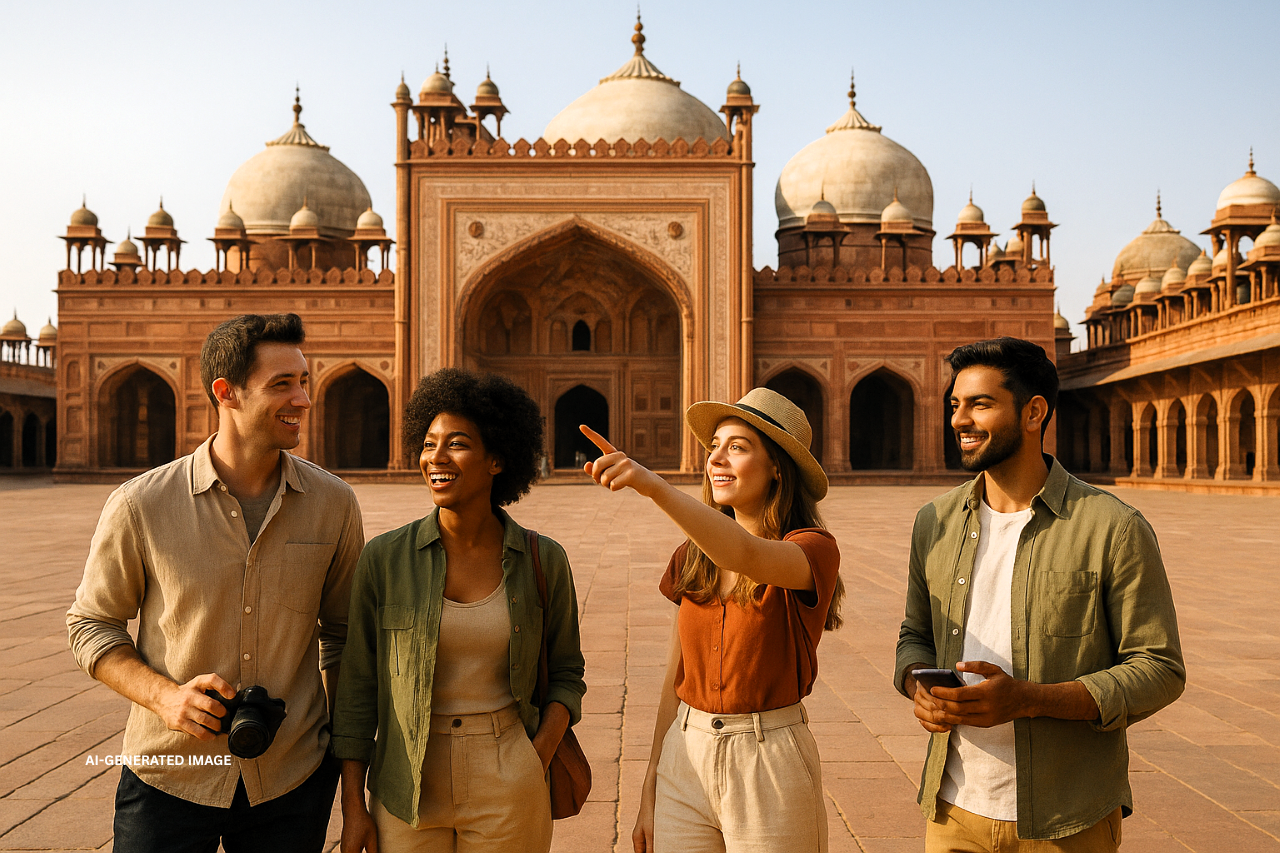
-
History:
-
Built by Emperor Akbar in the late 16th century, Fatehpur Sikri served as the Mughal capital for only 14 years before being abandoned due to a lack of water.
-
Key Attractions:
-
Visitors can explore Buland Darwaza (the “Gate of Magnificence”), Jama Masjid, Panch Mahal, and the Tomb of Salim Chishti.
-
Why Visit:
-
Walking through Fatehpur Sikri feels like stepping into a frozen chapter of history, offering insight into Mughal ambitions and challenges.
Itimad-ud-Daulah’s Tomb (Baby Taj)
Often referred to as the Baby Taj, this exquisite tomb frequently surprises visitors with its beauty and detail.
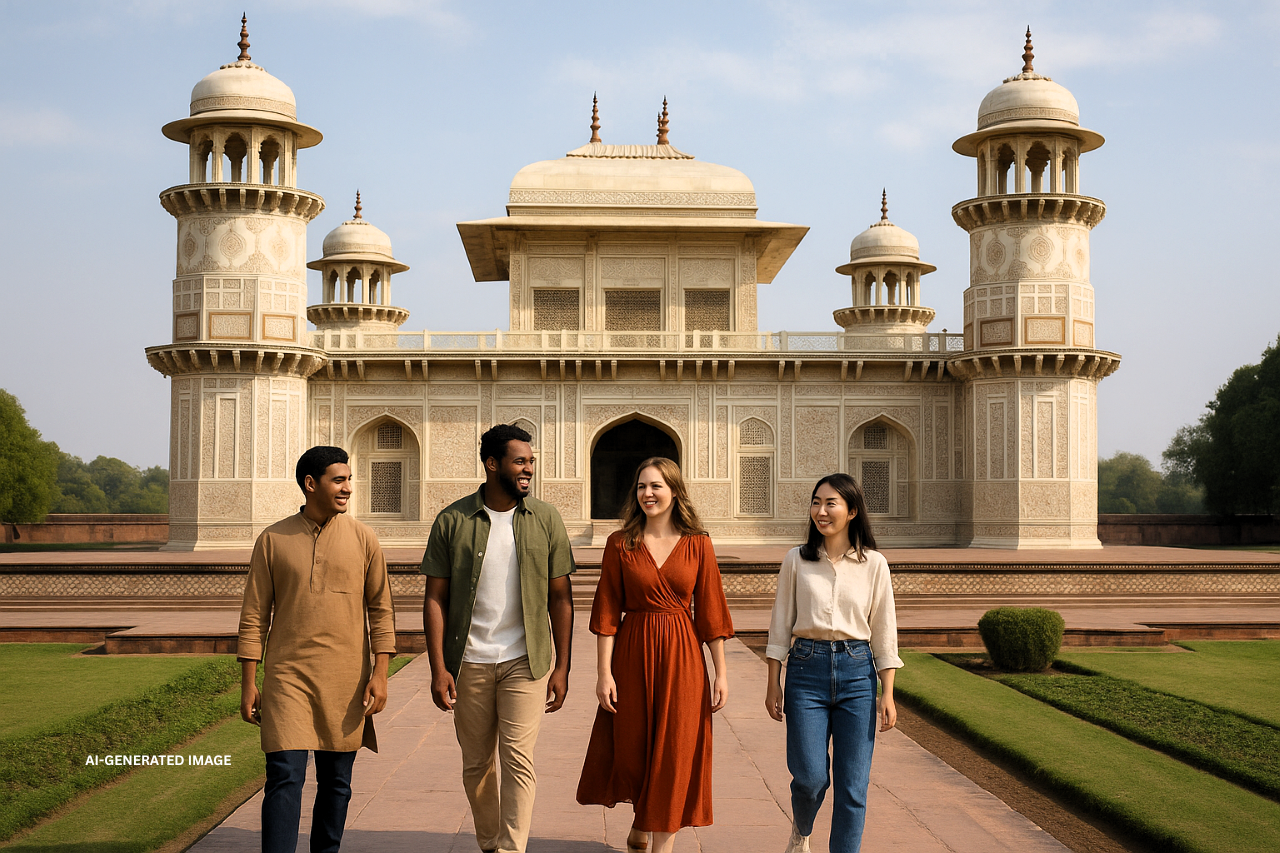
-
History & Patronage:
-
Commissioned by Empress Nur Jahan for her father, Mirza Ghiyas Beg, the tomb predates the Taj Mahal and is often considered its architectural prototype.
-
Design Features:
-
Built in white marble, it features delicate lattice screens (jali work) and intricate pietra dura inlay. Its Persian-inspired gardens add to its charm.
-
Why Visit:
-
The Baby Taj is less crowded than other sites, making it an ideal spot for those who wish to appreciate Mughal artistry in a peaceful setting.
Akbar’s Tomb at Sikandra
Another essential stop among the things to do in Agra is the resting place of Emperor Akbar, located in the suburb of Sikandra.
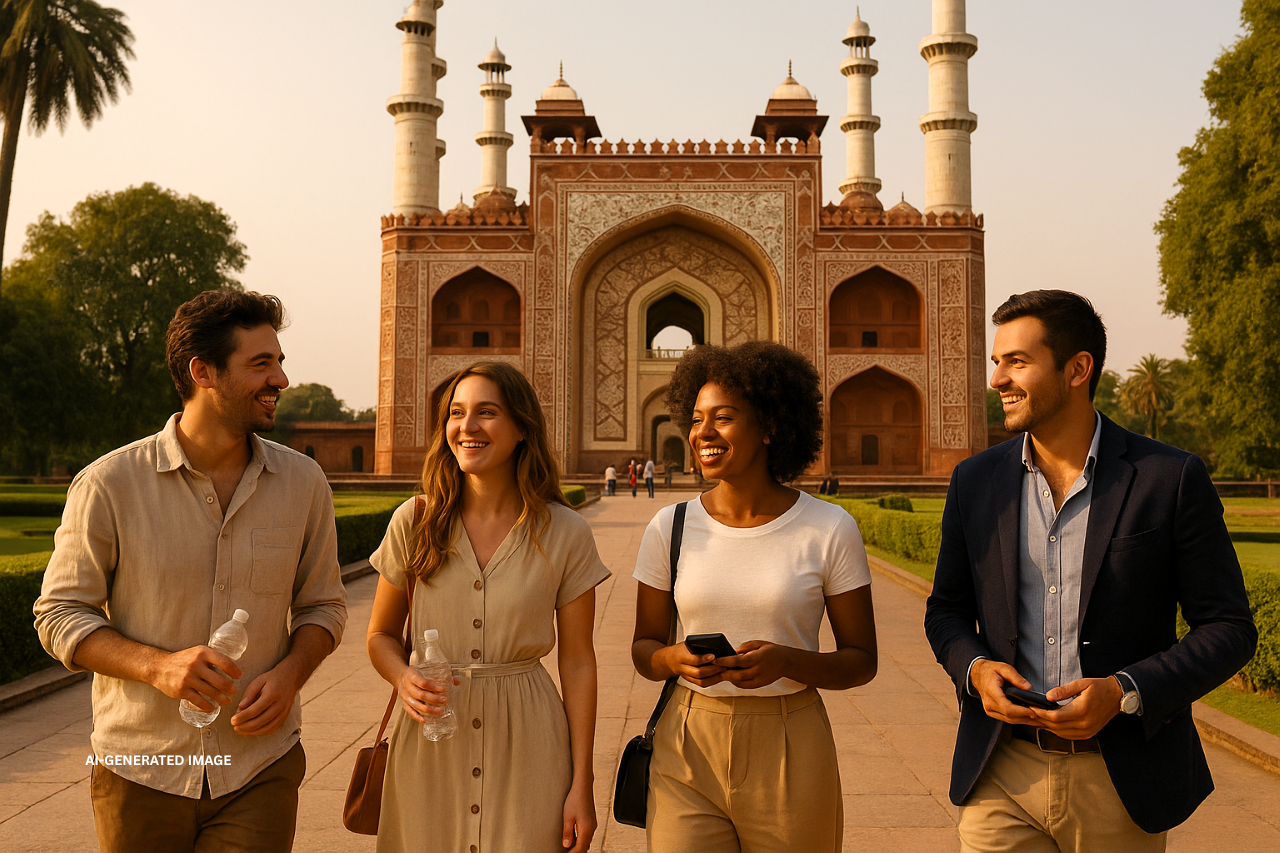
-
Architectural Style:
-
The tomb reflects Akbar’s vision of religious harmony by incorporating motifs from Hindu, Christian, Buddhist, and Islamic traditions.
-
Visitor Experience:
-
The entrance is through a grand red sandstone gateway decorated with marble inlay. The surrounding gardens are home to peacocks, deer, and monkeys, adding to the serene environment.
-
Why Visit:
-
The monument is not only the burial site of one of India’s greatest emperors but also a testament to his progressive and inclusive philosophy.
Religious & Cultural Attractions in Agra
Agra is often admired for its Mughal monuments, but the city is also home to vibrant places of worship that reflect its diverse spiritual heritage. From mosques and temples to gurudwaras, these sites highlight Agra’s cultural richness and are important stops for travelers. Exploring them is among the most authentic things to do in Agra.
Jama Masjid – The Grand Mosque of Agra
One of the most significant places to visit in Agra is the Jama Masjid, commissioned by Emperor Shah Jahan in 1648 for his daughter, Jahanara Begum.
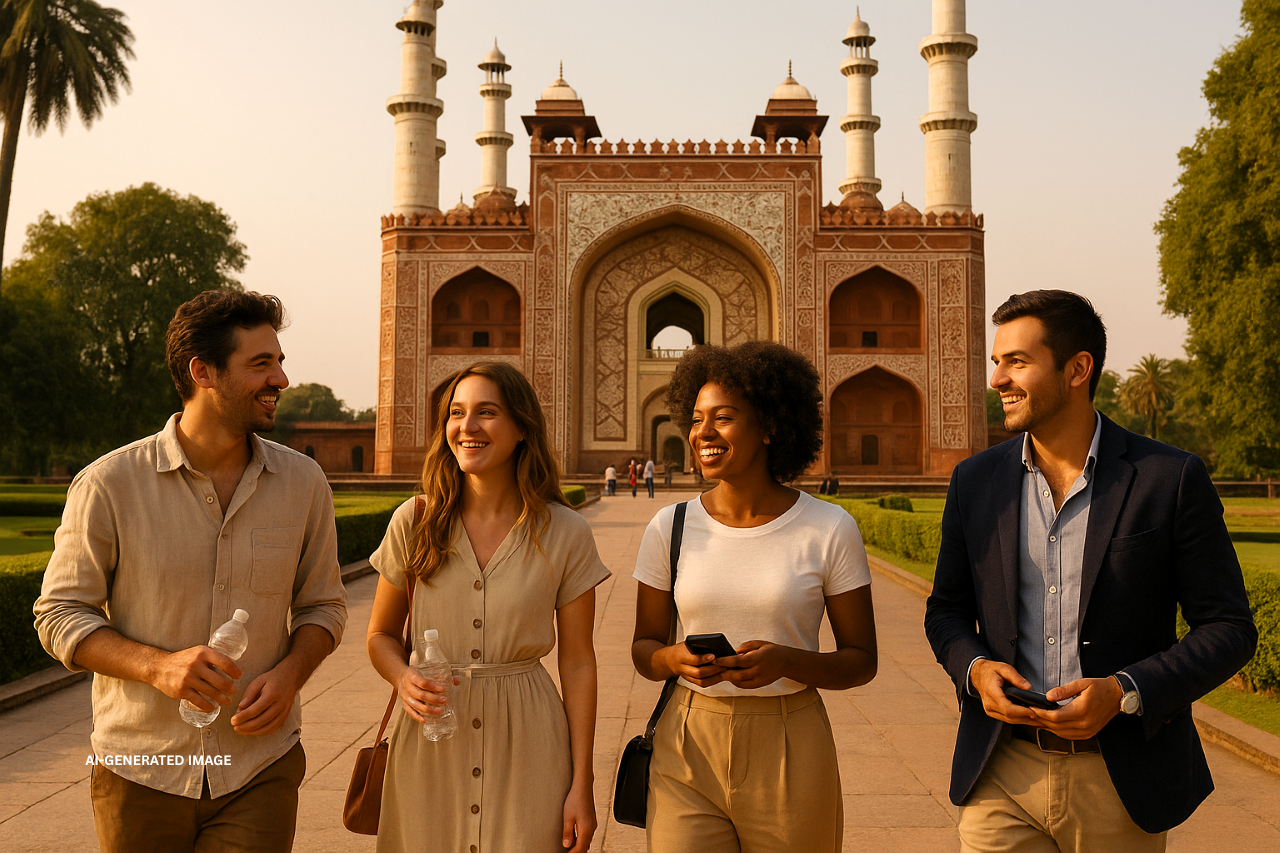
-
Architecture:
-
The mosque is built from red sandstone with elegant white marble inlay and features three impressive domes and a vast courtyard.
-
Spiritual Importance:
-
Even today, it serves as a major center of worship. On Fridays, the mosque fills with devotees for the weekly congregational prayer.
-
Visitor Tips:
-
Modest dress is recommended, and it’s best to visit outside prayer hours to explore the mosque’s peaceful surroundings.
A visit to Jama Masjid combines history and devotion, making it one of the essential things to do in Agra beyond the Taj Mahal.
Mankameshwar Temple – A Sacred Shiva Shrine
For those interested in Hindu culture, the Mankameshwar Temple is one of the most revered places to visit in Agra.
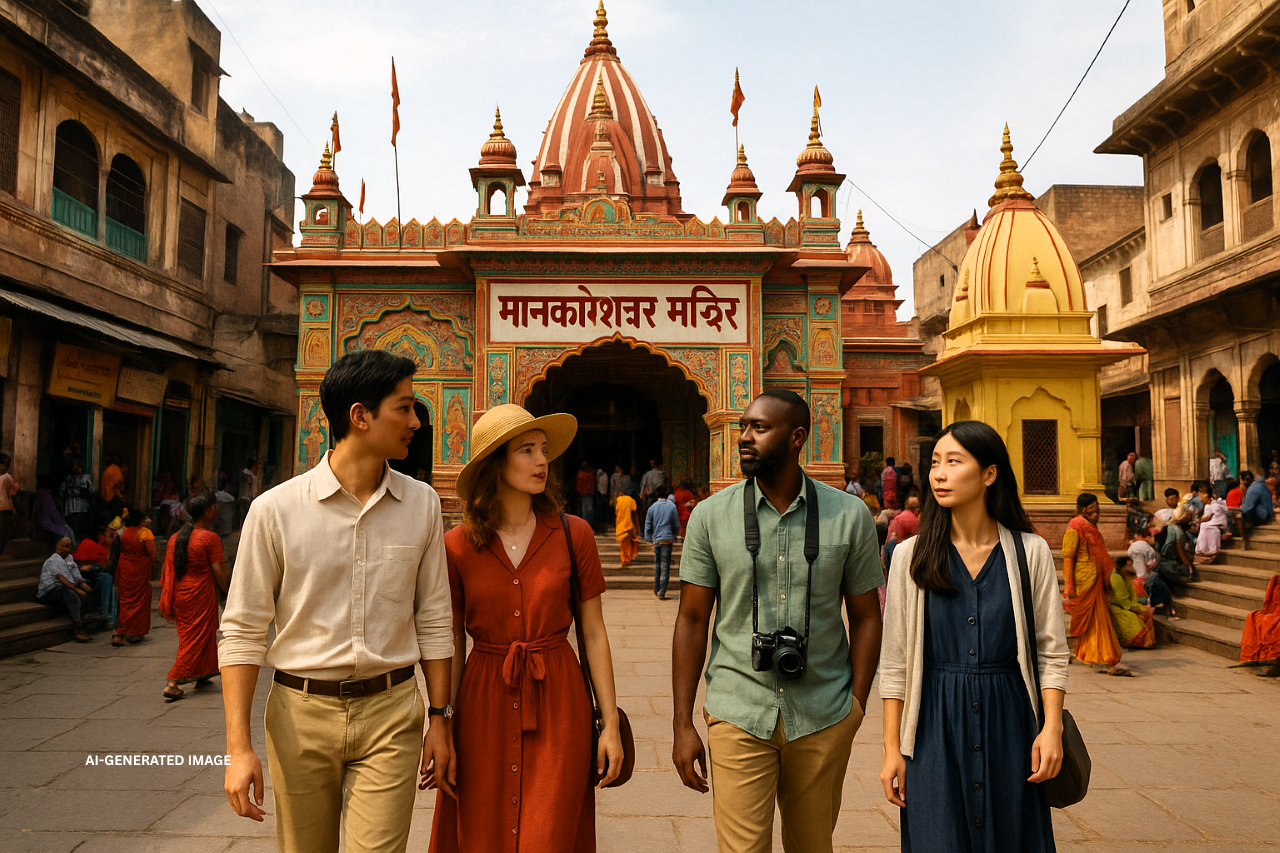
-
Historical & Religious Background:
-
Dedicated to Lord Shiva, this temple is believed to be thousands of years old. Local legends connect it with stories from Lord Krishna’s era.
-
Location & Atmosphere:
-
Situated near Agra Fort, the temple lies in a busy neighborhood, surrounded by narrow lanes buzzing with local life. Inside, pilgrims offer prayers and pour milk over the sacred Shiva Lingam.
-
Why Visit:
-
Visiting the temple offers a chance to witness living traditions in Agra and provides an authentic cultural experience beyond its Mughal past.
Including the Mankameshwar Temple in your itinerary ensures a balance between history and spirituality when exploring the things to do in Agra.
Guru ka Tal – A Sacred Sikh Site
Another highlight is Guru ka Tal, an important Sikh pilgrimage site.
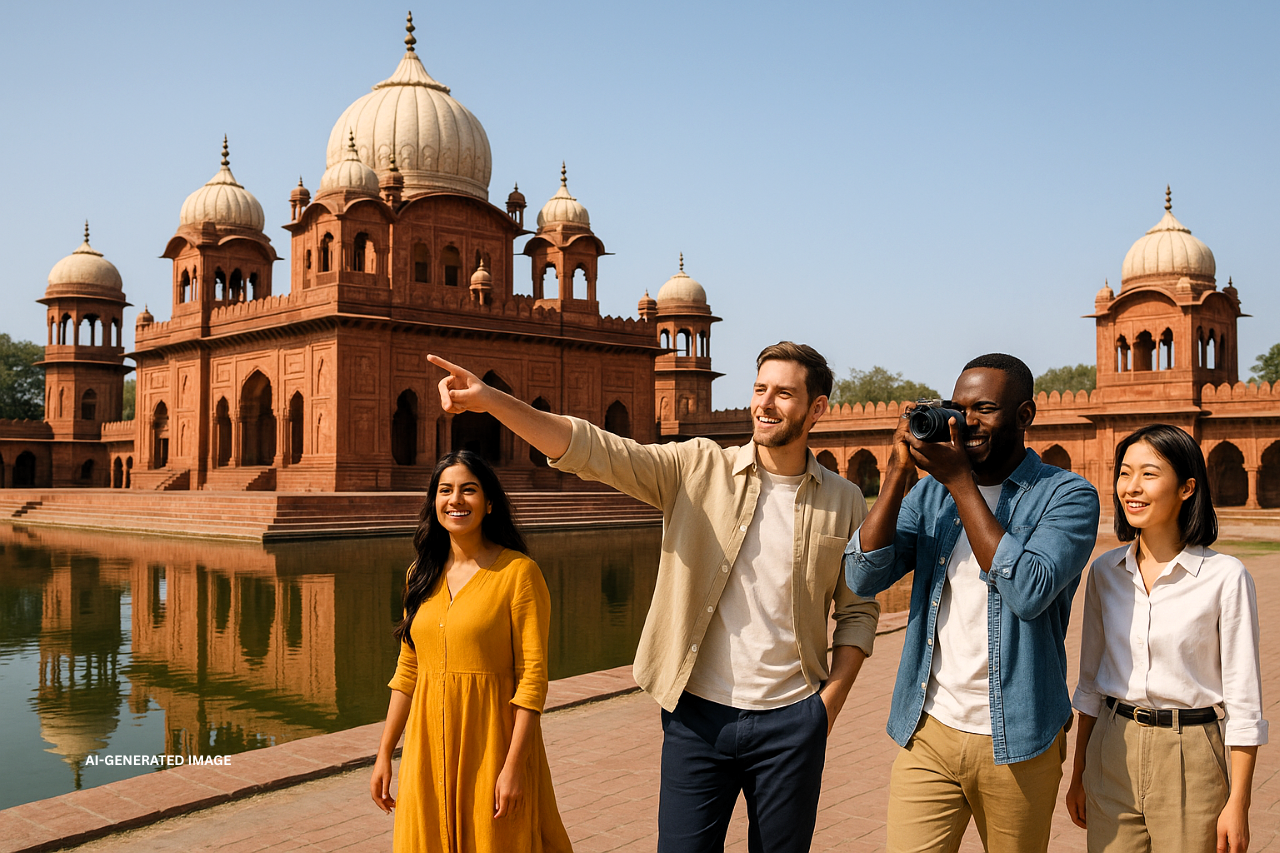
-
History:
-
This gurudwara stands at the location where Guru Tegh Bahadur, the ninth Sikh Guru, offered himself for arrest during the reign of Aurangzeb.
-
Architecture:
-
Originally a reservoir from the Mughal period, it was later developed into a gurudwara. The structure includes striking red sandstone pavilions combined with Sikh religious design.
-
Visitor Experience:
-
Guests are welcome to participate in prayers, listen to devotional music (kirtan), and share in the community kitchen (langar).
For those who want to explore Agra’s diversity, Guru ka Tal is one of the most meaningful places to visit in Agra, showcasing its pluralistic heritage.
Why Religious & Cultural Sites Matter in Agra
Agra’s monuments represent Mughal grandeur, but its mosques, temples, and gurudwaras reflect the city’s living traditions. Visiting them is more than sightseeing — it offers a deeper understanding of Agra’s cultural identity. Adding these destinations to your itinerary ensures your list of things to do in Agra captures not just its history but also the faith and spirit of its people.
Museums, Art & Heritage in Agra
Agra may be celebrated worldwide for the Taj Mahal, but the city has much more to offer. Beyond its iconic monuments, Agra’s museums, gardens, and heritage sites reveal fascinating stories about its past. For curious travelers, exploring these attractions is among the most rewarding things to do in Agra, as they showcase the artistic and cultural depth of the city.
Taj Museum – A Hidden Treasure Inside the Taj Complex
The Taj Museum, located inside the Taj Mahal complex, is often overlooked but is one of the most insightful places to visit in Agra.
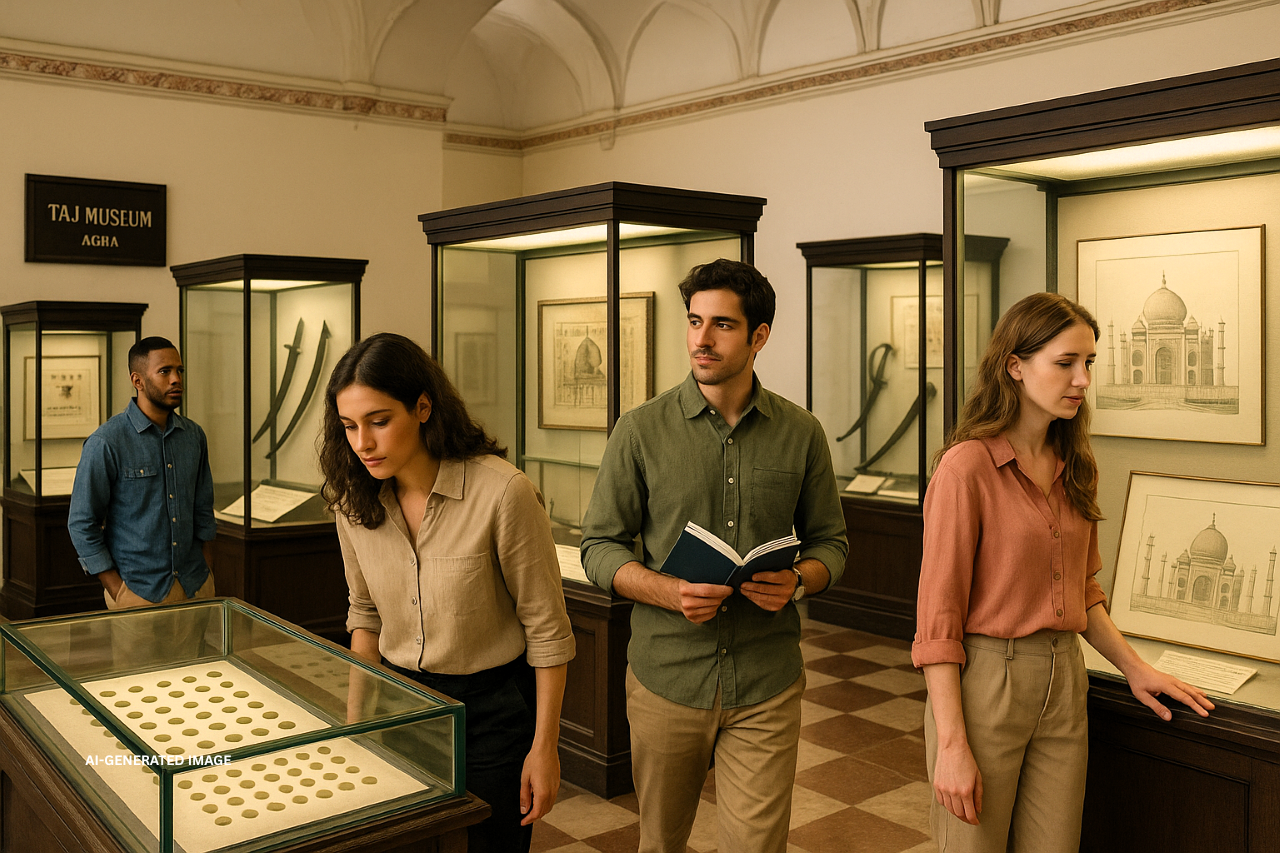
-
Highlights:
-
The museum preserves rare Mughal artifacts such as coins, manuscripts, calligraphy, weapons, and even original architectural drawings used in the construction of the Taj Mahal. Royal decrees (farmans) signed by emperors are also displayed.
-
Why Visit:
-
Visiting the museum adds another layer of appreciation to the Taj Mahal, helping travelers understand the immense planning and artistry that went into its creation.
Mehtab Bagh – The Moonlit Garden
For photographers and romantics, Mehtab Bagh is one of the most enchanting places to visit in Agra.
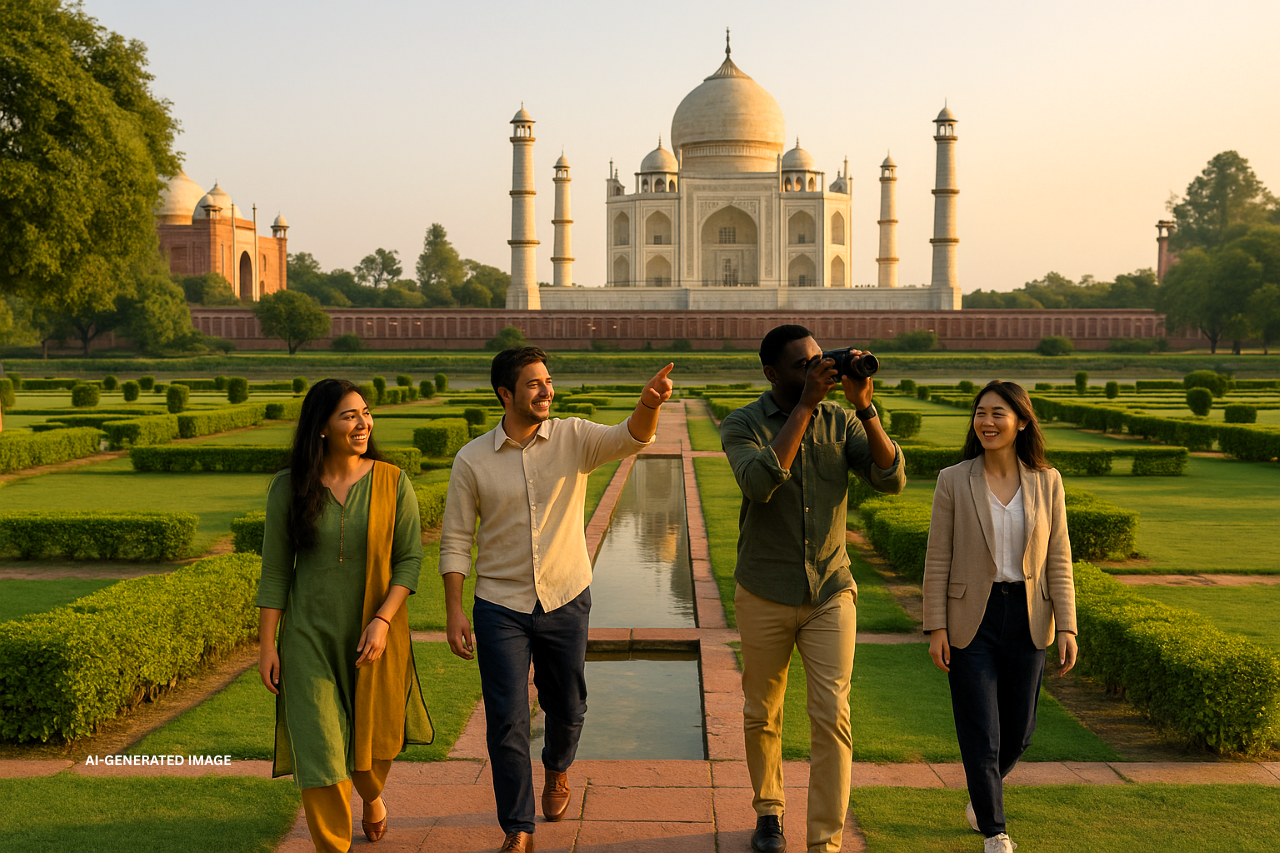
-
History:
-
This Persian-style garden, located across the Yamuna River, was originally laid out by Emperor Babur and later redesigned by Shah Jahan to perfectly align with the Taj Mahal.
-
Visitor Experience:
-
Known as the “Moonlight Garden,” it offers an exceptional view of the Taj Mahal, particularly at sunset, when the monument glows against the river backdrop.
-
Why Visit:
-
The peaceful environment makes Mehtab Bagh a favorite among visitors seeking quieter alternatives to the crowded Taj Mahal grounds.
Chini Ka Rauza – A Blend of Persian and Mughal Art
If you enjoy discovering hidden gems, Chini Ka Rauza is one of the most unique places to visit in Agra.
-
Background:
-
This 17th-century mausoleum was built for Afzal Khan Mullah, a poet and scholar who served in Shah Jahan’s court.
-
Architecture:
-
Unlike other Mughal structures, this tomb is decorated with colorful glazed Persian tiles, which earned it the name Chini (meaning “porcelain”).
-
Why Visit:
-
Its vibrant patterns and rare design style make it a fascinating stop for art and history enthusiasts.
Anguri Bagh – The Garden of Grapes
Inside Agra Fort lies Anguri Bagh, a heritage garden that reflects the Mughal love for leisure and elegance.
-
History:
-
Built by Shah Jahan in the 17th century, this garden was once filled with grapevines, fountains, and aromatic flowers.
-
Design:
-
It is arranged in symmetrical, geometric patterns and surrounded by royal apartments once used by queens and courtiers.
-
Visitor Experience:
-
Today, Anguri Bagh is a tranquil spot to stroll and imagine the royal life of the Mughal court.
Agra’s Handicrafts & Marble Inlay Art
Shopping in Agra is more than just buying souvenirs — it’s a journey into the city’s artistic heritage. Exploring handicrafts is one of the most immersive things to do in Agra.
-
Marble Inlay Work:
-
Artisans continue the pietra dura craft used in the Taj Mahal, creating tabletops, jewelry boxes, and decorative art pieces.
-
Leather Products:
-
Agra is known for its leather shoes, bags, and accessories.
-
Textiles & Carpets:
-
Handwoven carpets and zardozi embroidery add to the city’s artisan legacy.
-
Where to Shop:
-
Kinari Bazaar and Sadar Bazaar for handicrafts, and Shilpgram for artisan demonstrations.
Buying directly from workshops ensures authenticity and supports local craftsmanship.
Kalakriti Cultural & Convention Center – History in Performance
For an evening of culture and entertainment, the Kalakriti Cultural & Convention Center is a must.
-
Main Attraction:
-
The center hosts the famous stage performance “Mohabbat the Taj,” a musical drama that retells the love story of Shah Jahan and Mumtaz Mahal through dance, music, and dazzling sets.
-
Why Visit:
-
The show is both educational and entertaining, making it a unique way to experience Agra’s history.
-
Tip:
-
Reserve tickets early, as the show is popular with both domestic and international tourists.
Why Museums & Heritage Sites Matter in Agra
These museums, gardens, and cultural centers enrich your understanding of Agra beyond its world-famous monuments. Exploring them offers a more complete picture of the city — one that includes art, leisure, craftsmanship, and storytelling. Adding these experiences to your itinerary ensures your list of things to do in Agra covers history, culture, and creativity in equal measure.
Cultural Experiences & Local Life in Agra
Agra may be known worldwide for the Taj Mahal, but its true essence lies in the city’s living culture. From food and handicrafts to bazaars and performances, these experiences bring Agra to life in ways that monuments alone cannot. Exploring them is one of the most rewarding things to do in Agra, offering travelers a deeper connection with the city and its people.
Mughal Heritage Walk – A Journey into Local Life
The Mughal Heritage Walk is a community-based initiative designed to give visitors a glimpse of Agra beyond its tourist spots.
-
What It Offers:
-
The walk takes you through Kachhpura village, located across the Yamuna River. Along the way, you can see lesser-known Mughal-era monuments such as Humayun’s Mosque and the remains of Gyarah Sidi.
-
Local Interaction:
-
Visitors meet residents, see artisans at work, and often enjoy tea in a traditional village setting.
-
Why It Matters:
-
This walk supports local communities and sustainable tourism while giving travelers an authentic experience.
Adding the Mughal Heritage Walk to your itinerary ensures your list of things to do in Agra includes both cultural engagement and historical exploration.
Agra’s Street Food Tour – A Feast of Flavors
No visit to Agra is complete without indulging in its street food. Sampling local dishes is one of the most delicious things to do in Agra.
-
Must-Try Specialties:
-
Petha:
-
A translucent sweet made from ash gourd, available in classic and flavored varieties.
-
Bedai with Aloo Sabzi:
-
A traditional breakfast of spiced bread served with potato curry.
-
Mughlai Kebabs and Curries:
-
Rich, aromatic dishes inspired by the royal kitchens.
-
Dalmoth:
-
A crunchy lentil-based snack.
-
-
Best Food Spots:
-
Sadar Bazaar for petha and chaat, Kinari Bazaar for local snacks, and Fatehabad Road for Mughlai cuisine.
Tasting Agra’s specialties is more than a meal — it’s a cultural journey through flavors passed down for generations.
Shopping for Handicrafts & Marble Inlay Work
Agra is a city of artisans, and shopping here is a cultural experience in itself. Exploring handicrafts is one of the most creative things to do in Agra.
-
Marble Inlay Art:
-
Known as pietra dura, this technique involves embedding semi-precious stones into marble, the same craft seen in the Taj Mahal.
-
Leather Goods:
-
Agra’s leather industry is famous for high-quality shoes, bags, and accessories.
-
Textiles & Carpets:
-
Handwoven carpets and intricate zardozi embroidery reflect Mughal luxury.
-
Shopping Districts:
-
Kinari Bazaar and Sadar Bazaar are the best-known markets, while Shilpgram offers artisan demonstrations.
Buying directly from authentic workshops not only guarantees quality but also supports local craftsmen.
Kalakriti Cultural & Convention Center – History on Stage
If you’re looking for an evening activity, the Kalakriti Cultural Center offers a blend of entertainment and history.
-
The Main Attraction:
-
The popular play Mohabbat the Taj dramatizes the love story of Shah Jahan and Mumtaz Mahal through dance, music, and elaborate sets.
-
Why It’s Worth Seeing:
-
The performance makes history engaging and accessible, especially for international visitors.
-
Tip:
-
Reserve tickets in advance, as the show often sells out.
This cultural performance adds depth to your itinerary, making it one of the more unique things to do in Agra at night.
Exploring Agra’s Local Bazaars
Agra’s bustling bazaars are full of energy and color. Visiting them is one of the most authentic things to do in Agra.
-
Kinari Bazaar:
-
Famous for wedding attire, jewelry, and handicrafts.
-
Sadar Bazaar:
-
Popular for leather goods, street food, and souvenirs.
-
Subhash Bazaar:
-
Known for silk and textiles.
-
Raja Ki Mandi:
-
A lively local market selling everything from clothes to everyday essentials.
These markets are not just shopping destinations — they are vibrant cultural spaces where you can experience the city’s daily rhythm.
Why Cultural Experiences Make Agra Special
While its monuments define Agra’s global image, its culture and traditions give the city its heart. From savoring sweets to bargaining in bazaars, or watching history come alive on stage, these experiences reveal a living, breathing Agra. Adding these activities to your itinerary ensures your list of places to visit in Agra goes beyond landmarks and connects with the soul of the city.
Day Trips & Excursions from Agra
Agra is not only a treasure trove of Mughal monuments but also a convenient base for exploring nearby destinations. From sacred towns to wildlife sanctuaries, these short excursions add variety and depth to your itinerary. For travelers with extra time, these day trips are some of the most rewarding things to do in Agra and its surroundings.
Mathura & Vrindavan – The Land of Krishna
A trip to Mathura and Vrindavan is one of the most popular places to visit near Agra, especially for those interested in spirituality.
-
Distance:
-
Around 55 km from Agra, reachable in about 1–1.5 hours by road.
-
Mathura Highlights:
-
The Krishna Janmabhoomi Temple, believed to mark Lord Krishna’s birthplace, and the Vishram Ghat on the Yamuna River, where pilgrims gather for evening rituals.
-
Vrindavan Highlights:
-
Famous for the Banke Bihari Temple, ISKCON Temple, and the dazzling Prem Mandir, which is beautifully illuminated at night.
-
Best Time to Visit:
-
During festivals like Holi or Janmashtami, both towns come alive with music, devotion, and color.
This day trip blends spirituality and culture, making it one of the most fulfilling things to do in Agra beyond its monuments.
Bharatpur Bird Sanctuary (Keoladeo National Park)
Nature enthusiasts will find Bharatpur Bird Sanctuary (Keoladeo National Park) a refreshing escape.
-
Distance:
-
About 55 km from Agra, an easy drive of just over an hour.
-
Why It’s Famous:
-
This UNESCO World Heritage Site is home to over 350 species of birds, including rare migratory visitors like Siberian cranes, pelicans, and painted storks.
-
Experiences:
-
Visitors can explore on foot, by bicycle, or in cycle rickshaws guided by naturalists.
-
Why Visit:
-
It offers a peaceful break from city crowds and is a paradise for birdwatchers and photographers.
For wildlife lovers, this sanctuary is one of the most unique places to visit in the Agra region.
Chambal Wildlife Safari – A Riverside Adventure
For an offbeat experience, the Chambal River Safari is among the most exciting things to do near Agra.
-
Distance:
-
Approximately 80 km from Agra, a 1.5 to 2-hour drive.
-
Wildlife:
-
The river is home to endangered gharials (long-snouted crocodiles), freshwater dolphins, and several species of migratory birds.
-
What to Do:
-
Motorized boat rides allow visitors to observe wildlife in their natural habitat.
-
Why Visit:
-
It combines adventure with eco-tourism, making it ideal for those who want to explore beyond history and architecture.
Sikandra – Akbar’s Resting Place
Though located on the outskirts of Agra, Sikandra is worth including in your itinerary.
-
What to See:
-
The tomb of Emperor Akbar, surrounded by expansive gardens populated with peacocks, antelopes, and monkeys.
-
Architecture:
-
The monument combines elements of Hindu, Christian, Islamic, and Buddhist design, reflecting Akbar’s vision of religious harmony.
-
Why Visit:
-
It offers a quiet and serene atmosphere, away from the busier sites.
Sikandra adds both history and tranquility to your list of places to visit in Agra.
Etmadpur – The Artisan’s Trail
For a more intimate cultural experience, head to Etmadpur, known for its artisan workshops.
-
Specialties:
-
Marble inlay, stone carving, and other traditional crafts that echo the artistry of the Taj Mahal.
-
Why Visit:
-
Unlike touristy markets, Etmadpur allows you to see artisans working in small studios, often passing their skills through generations.
-
Best For:
-
Travelers who want authentic souvenirs and direct interaction with craftsmen.
Exploring Etmadpur is one of the most enriching things to do in Agra’s surroundings, especially for those who value cultural immersion.
Why Day Trips Enhance Your Agra Experience
Agra’s monuments are undeniably stunning, but nearby destinations expand your journey. Whether you’re exploring the sacred streets of Vrindavan, cycling through Bharatpur’s bird sanctuary, gliding along the Chambal River, or observing artisans at work in Etmadpur, these trips ensure that your list of things to do in Agra is as diverse as it is memorable.
Practical Travel Information for Agra
To truly enjoy all the wonderful things to do in Agra, travelers need more than just a sightseeing list. Practical planning — from timing your trip to choosing where to stay — will make your experience smooth and memorable. Here’s a complete guide to help you prepare.
Best Time to Visit Agra
-
Winter (October – March):
-
The most pleasant season, with cool weather ideal for exploring monuments. This is peak tourist time, so attractions can be crowded.
-
Summer (April – June):
-
Extremely hot, with temperatures often rising above 40°C. Early mornings are the best time to visit monuments if you travel during this period.
-
Monsoon (July – September):
-
Rain brings greenery and fewer crowds, though humidity can make travel less comfortable.
-
Festival Highlight:
-
The Taj Mahotsav, held each February, is a 10-day celebration of art, culture, food, and music.
👉 For most visitors, November to February is the best window to explore all the major places to visit in Agra.
How to Reach Agra
Agra is well-connected and easily accessible from major cities in India.
-
By Air:
-
Kheria Airport serves Agra but has limited flights. The nearest international airport is in Delhi, about 230 km away.
-
By Train:
-
Agra Cantt is the main station, connected by fast trains like the Gatimaan Express and Shatabdi Express from Delhi.
-
By Road:
-
The Yamuna Expressway makes the drive from Delhi smooth and fast, taking around three to four hours.
-
By Bus:
-
Frequent government and private bus services connect Agra to Delhi, Jaipur, and Lucknow.
Where to Stay in Agra
Agra offers a wide variety of accommodation options to suit every budget.
-
Luxury Hotels:
-
The Oberoi Amarvilas:
-
Every room provides a stunning view of the Taj Mahal.
-
ITC Mughal:
-
A luxury property designed with Mughal-inspired architecture.
-
-
Mid-Range Options:
-
Trident Agra, Radisson Blu, and Crystal Sarovar Premiere offer comfort at affordable rates.
-
Budget Stays:
-
Guesthouses and hostels around Fatehabad Road are ideal for backpackers.
💡 Travel Tip: Stay near the Taj Mahal’s East Gate if you want to catch the sunrise with fewer crowds. It’s one of the most magical things to do in Agra.
Safety & Travel Tips
-
Avoiding Crowds:
-
Visit popular sites like the Taj Mahal and Agra Fort early in the morning.
-
Dress Code:
-
Modest clothing is advisable, especially when visiting temples and mosques.
-
Beware of Scams:
-
Use only authorized guides and buy souvenirs from trusted shops to avoid overpriced or fake products.
-
Transport:
-
Cycle-rickshaws and auto-rickshaws are widely available; for longer trips, use ride-hailing apps like Ola.
-
Entry Rules:
-
The Taj Mahal does not allow food items, large bags, or drones. Carry only essentials.
With these tips, you’ll be ready to enjoy all the top places to visit in Agra without unnecessary hassles.
Conclusion
Agra is a city where history, culture, and everyday life come together to create an unforgettable travel experience. While the Taj Mahal is its shining star, the city offers far more — from the grandeur of Agra Fort and Fatehpur Sikri to the serenity of Mehtab Bagh, bustling bazaars, delicious street food, and lively cultural performances.
Day trips to Mathura, Vrindavan, Bharatpur, and Chambal further enrich your journey, showing that Agra is not just a quick stop but a destination in itself. Whether you’re staying for a day or a few, there is no shortage of memorable things to do in Agra.
FAQs
How many days should I spend in Agra?
Two days are enough to see the Taj Mahal, Agra Fort, and local markets. A third day allows time for Fatehpur Sikri and nearby excursions.
What is the best season to visit Agra?
The winter months (November–February) offer the best weather for sightseeing and photography.
Can Agra be visited as a day trip from Delhi?
Yes. Thanks to the Yamuna Expressway and high-speed trains, Agra is a popular one-day trip. However, staying overnight gives you more time to explore at a relaxed pace.
What foods should I try in Agra?
Try petha (a famous sweet), Bedai with aloo sabzi, Mughlai kebabs, and the snack dalmoth. Street food tours are highly recommended.
Are there any offbeat places to visit in Agra?
Yes. Chini Ka Rauza, Mehtab Bagh, and Etmadpur’s artisan workshops are quieter but equally fascinating.
Is Agra safe for tourists?
Agra is generally safe. Follow basic precautions like avoiding isolated areas at night, keeping valuables secure, and using official guides.
